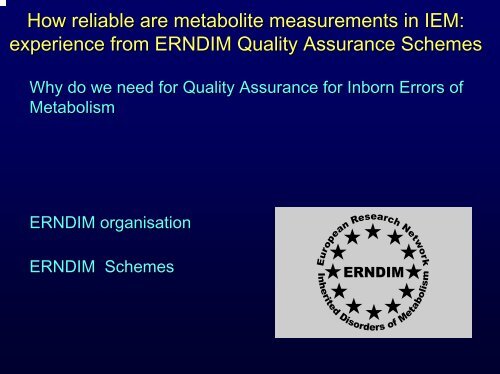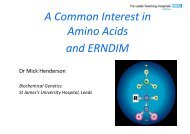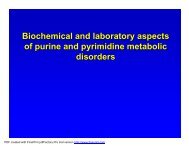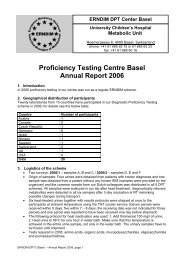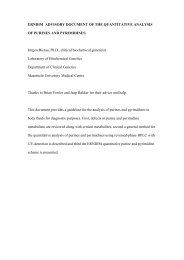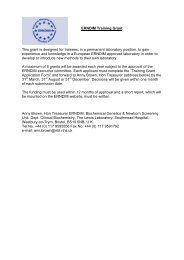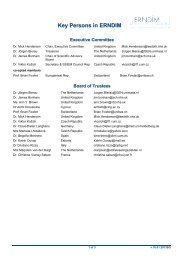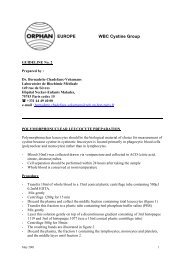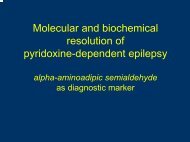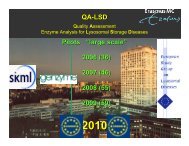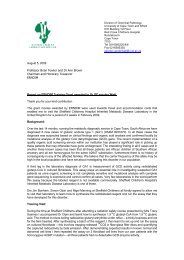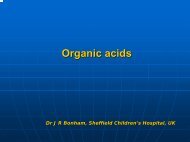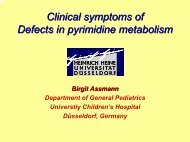How reliable are metabolite measurements in IEM - ERNDIM
How reliable are metabolite measurements in IEM - ERNDIM
How reliable are metabolite measurements in IEM - ERNDIM
Create successful ePaper yourself
Turn your PDF publications into a flip-book with our unique Google optimized e-Paper software.
<strong>How</strong> <strong>reliable</strong> <strong>are</strong> <strong>metabolite</strong> <strong>measurements</strong> <strong>in</strong> <strong>IEM</strong>:<br />
experience from <strong>ERNDIM</strong> Quality Assurance Schemes<br />
Why do we need for Quality Assurance for Inborn Errors of<br />
Metabolism<br />
<strong>ERNDIM</strong> organisation<br />
<strong>ERNDIM</strong> Schemes
Quality Assurance <strong>in</strong> <strong>IEM</strong> is essential<br />
• agreed thresholds of <strong>metabolite</strong> levels for treatment<br />
• validity of published data / <strong>in</strong>clusion of patients <strong>in</strong> multicentre<br />
studies<br />
• agreed critical cutoff values <strong>in</strong> newborn screen<strong>in</strong>g (tandem MS)<br />
• Mobility of patients<br />
Email <strong>in</strong> metab-l metab<br />
«…Our «…Our<br />
patient with ……. …….<br />
Aciduria will be on vacation <strong>in</strong> XXX<br />
with his family; the p<strong>are</strong>nts ask if there is a metabolic center<br />
near XXX where a metabolic control for adapt<strong>in</strong>g the treatment<br />
could be done. »
Why is Quality Assurance <strong>in</strong> <strong>IEM</strong> essential<br />
• agreed thresholds of <strong>metabolite</strong> levels for treatment<br />
• validity of published data / <strong>in</strong>clusion of patients <strong>in</strong> multicentre<br />
studies<br />
• agreed critical cutoff values <strong>in</strong> newborn screen<strong>in</strong>g (tandem MS)<br />
• Mobility of patients<br />
Interpretation of data from different laboratories <strong>in</strong> a patient<br />
demands comparability of <strong>measurements</strong> of the two labs
<strong>ERNDIM</strong> Provides European-Wide European Wide Quality<br />
Assurance s<strong>in</strong>ce 1994<br />
Aims of <strong>ERNDIM</strong><br />
Consensus on procedures for diagnosis, treatment and<br />
monitor<strong>in</strong>g of <strong>in</strong>herited metabolic diseases.<br />
Quality control schemes operated accord<strong>in</strong>g to accepted norms<br />
Education<br />
Meet<strong>in</strong>gs, Recommended Operat<strong>in</strong>g Procedures<br />
Annual reports of schemes on the <strong>in</strong>ternet. <strong>in</strong>ternet<br />
Value alue for money<br />
M<strong>in</strong>imal adm<strong>in</strong>istration costs and efficient subscription<br />
collection.
<strong>ERNDIM</strong> web-site: web site: www.erndim<br />
www. erndim.ch ch
Co-ord<strong>in</strong>ator: Jean-Jacques Cassiman<br />
University of Leuven, Belgium<br />
By Rebecca Kent
Plasma Am<strong>in</strong>o<br />
Acids (30)<br />
Current EQA Schemes<br />
Serum Special<br />
Assays<br />
Ur<strong>in</strong>e Special<br />
assays<br />
177 participants 158 participants 121 participants<br />
Ur<strong>in</strong>e Organic<br />
O-1-6<br />
Organic<br />
6<br />
Acids quantitative<br />
J.<br />
quantitative<br />
J. Bonham et al<br />
63 participants<br />
Diagnostic Proficiency<br />
Test<strong>in</strong>g <strong>in</strong> Ur<strong>in</strong>e<br />
93 participants<br />
Organic Acids <strong>in</strong><br />
ur<strong>in</strong>e<br />
Proficiency test<strong>in</strong>g<br />
137 participants<br />
Ur<strong>in</strong>e Pur<strong>in</strong>es<br />
and pyrimid<strong>in</strong>es<br />
White Blood<br />
Cell P-18 18-21<br />
Cyst<strong>in</strong>e<br />
21<br />
M Henderson et al.<br />
27 participants<br />
Blood Spots<br />
Acylcarnit<strong>in</strong>es<br />
45 participants 67 participants
<strong>ERNDIM</strong> Special Assay Schemes: Analytes 2006<br />
Ur<strong>in</strong>e<br />
5-OH OH-Indolacetic Indolacetic acid<br />
Carnit<strong>in</strong>e free<br />
Creat<strong>in</strong>e<br />
Creat<strong>in</strong><strong>in</strong>e<br />
Guanid<strong>in</strong>oacetate<br />
Homovanillic acid<br />
Hydroxyprol<strong>in</strong>e<br />
Lactic acid<br />
Mucopolysaccharides<br />
Orotic acid<br />
Pipecolic acid<br />
Sialic acid<br />
Succ<strong>in</strong>ylacetone<br />
Thiosulphate<br />
Uric acid<br />
Serum<br />
3-OH OH Butyric acid<br />
7-Dehydrocholesterol<br />
Dehydrocholesterol<br />
C22:0 Behenic acid<br />
C24:0 Lignoceric acid<br />
C26:0 Cerotic acid<br />
Carnit<strong>in</strong>e free<br />
Cis-4-deconic Cis deconic acid<br />
Creat<strong>in</strong>e<br />
Guanid<strong>in</strong>oacetate<br />
Homocyste<strong>in</strong>e<br />
Phenylalan<strong>in</strong>e<br />
Lactic acid<br />
Phytanic acid<br />
Pipecolic acid<br />
Pyruvic acid<br />
Uric acid
<strong>ERNDIM</strong> Am<strong>in</strong>o acid QC scheme:<br />
Participants – 177 from 26 countries<br />
Methods Participants (%)<br />
Ion-exchange Ion exchange chromatography + n<strong>in</strong>hydr<strong>in</strong> 82 %<br />
Ion-exchange Ion exchange chromatography + other deriv. 2 %<br />
Reverse phase HPLC 12 %<br />
GC (MS) 1.5 %<br />
Other 2 %
Am<strong>in</strong>o acid QC scheme: Phenylalan<strong>in</strong>e of 442 µmol/L mol/L<br />
Median 442<br />
12 labs > 50 µmol/L mol/L too high<br />
16 labs > 50 µmol/L mol/L too low
Mean all labs 12.9<br />
µmol/L mol/L
Mean all labs 114<br />
µmol/L mol/L
Am<strong>in</strong>o acid QC scheme: Precision vs. Interlab variation<br />
Between labs CV<br />
> %<br />
26<br />
24<br />
22<br />
20<br />
18<br />
16<br />
14<br />
12<br />
10<br />
8<br />
6<br />
4<br />
2<br />
0<br />
AspA<br />
AspN<br />
Cit<br />
His Met<br />
Leu<br />
ILeu GluA GluN<br />
Pro<br />
Gly Tau<br />
Val Thr<br />
Tyr<br />
Ala Lys<br />
Phe Ser<br />
Arg Orn<br />
Sarc<br />
αAB<br />
ASA<br />
Cysta<br />
0 2 4 6 8 10 12 14 16<br />
Cys<br />
1MeHis<br />
Precision, with<strong>in</strong> lab CV<br />
OH-Lys<br />
OH-Pro<br />
> %
<strong>in</strong>terlab CV for quantitative schemes 2005<br />
Scheme Best Worst<br />
Am<strong>in</strong>o Acids 6.4 % (Val<strong>in</strong>e) 253 % (hydroxyprol<strong>in</strong>e)<br />
Special assays Ur<strong>in</strong>e 12.7 % (Carnit<strong>in</strong>e) 198 % (sodium thiosulfate)<br />
Special Assays Serum 3.5 % (Uric Acid) 190 % (cis-4-decanoic acid)<br />
Organic Acids 42.5 % (ethylmalonate<br />
( ethylmalonate) ) 619 % (4-OH (4 OH-Butyric Butyric acid)<br />
Pur<strong>in</strong>es & Pyrimid<strong>in</strong>es 6.1% (creat<strong>in</strong><strong>in</strong>e) 234 % (dihydro-uracil)<br />
Cyst<strong>in</strong>e 12 % (prote<strong>in</strong>) 104 % (cyst<strong>in</strong>e)
% Correct<br />
Diagnostic Proficiency Test<strong>in</strong>g: Performance<br />
Prague Centre 2005<br />
120<br />
100<br />
80<br />
60<br />
40<br />
20<br />
0<br />
Alkaptonuria<br />
Adenylate<br />
succ<strong>in</strong>ate<br />
lyase def.<br />
Homocyst<br />
-<strong>in</strong>uria<br />
Glutaric<br />
aciduria I<br />
MPS III<br />
Mevalonic<br />
aciduria<br />
Analytical<br />
Interpretative<br />
Recommendations
<strong>How</strong> can we improve quality<br />
• Validation of methods and equipment<br />
• Standard methods<br />
• Internal QC<br />
• External QC<br />
EQA will play an <strong>in</strong>creas<strong>in</strong>g role <strong>in</strong> promot<strong>in</strong>g the much<br />
needed improvements of quality of analyte measurement<br />
<strong>in</strong> <strong>IEM</strong> and will become essential for the accreditation of<br />
laboratories.


